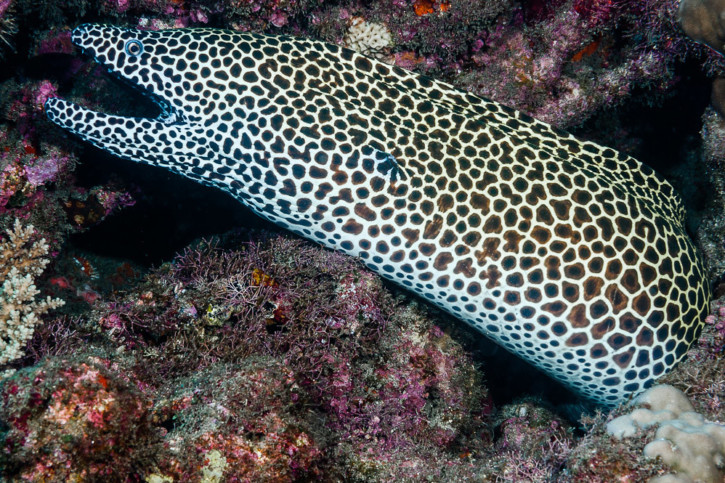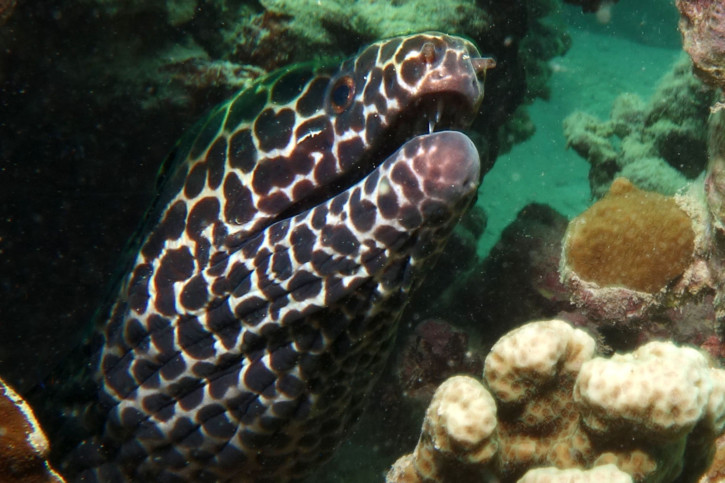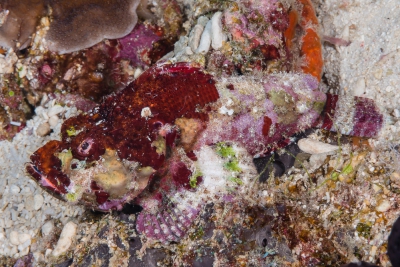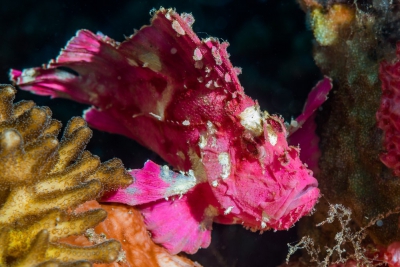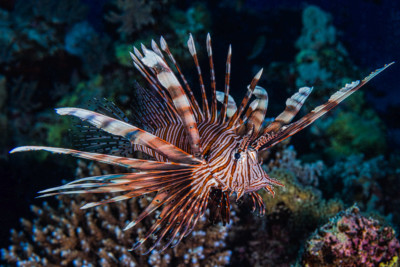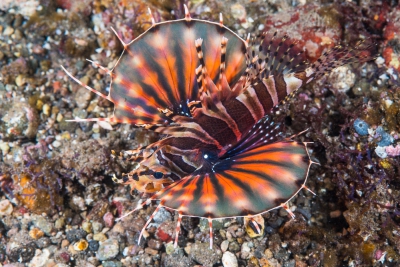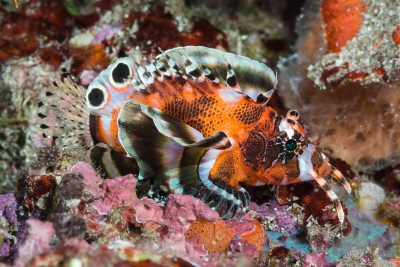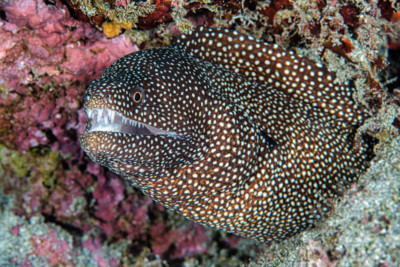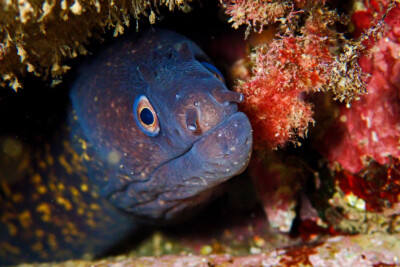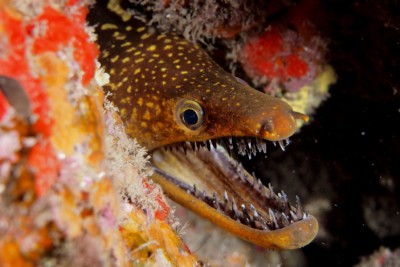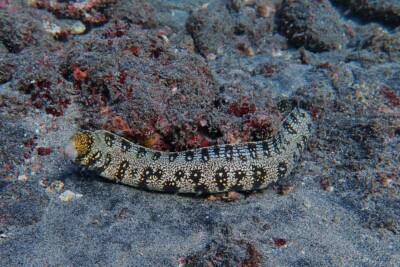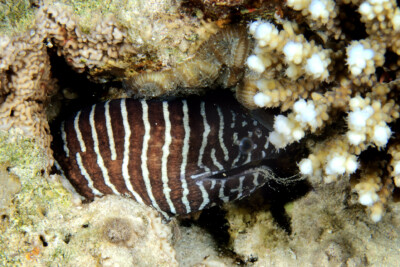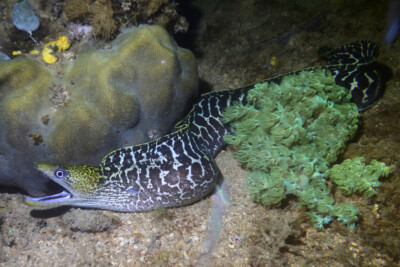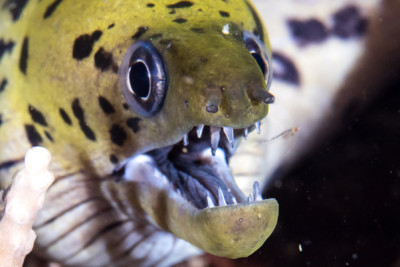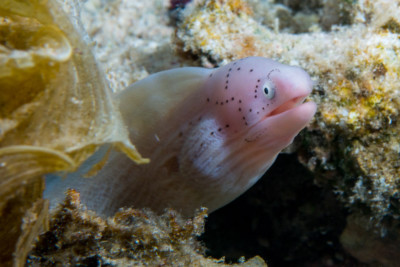tessellate moray
| Scientific name | Gymnothorax favagineus |
|---|---|
| Descriptor | Bloch & Schneider |
| Year of description | 1801 |
| IUCN category (World) | LC |
| Family | Muraenidae |
| Genus | Gymnothorax |
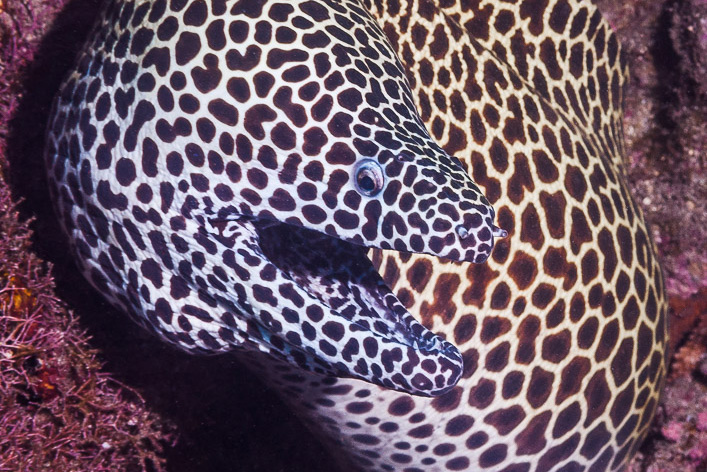

Introduction
Gymnothorax favagineus, commonly known as the tessellate moray, is a marine fish from the moray eel family. It gets its common name from the pattern it displays, reminiscent of the fur of the feline of the same name.
Reaching over three meters, it is one of the largest species of moray eels in the Indo-Pacific region, second only to the giant moray eel Gymnothorax javanicus.
Who is it?
Morphology
-
Type
-
Average size200 cm
-
Maximum size300 cm
-
Longevity30 year
-
Mimicrystone
-
Patternponctuations
-
Type
-
Average size200 cm
-
Maximum size300 cm
-
Longevity30 year
-
Mimicrystone
-
Patternponctuations
How to recognize This fish ?
The entire snake-like body of the tessellate moray is white and covered with dark brown spots of varying shapes, resembling the leopard's fur. Young individuals have wider spots compared to adults. The inside of the mouth is also spotted, which distinguishes it from the guineafowl moray (Gymnothorax meleagris) and the yellow-mouthed moray (Gymnothorax nudivomer) that have a similar pattern.
It is, however, harder to distinguish from Gymnothorax isingteena that has the same pattern with smaller and more scattered spots, and from the spotted moray (Gymnothorax moringa) which also has the same pattern with smaller and very dense spots.
Like its relatives, it breathes through gill pores on each side of its head, which can be seen as black holes when open.
Sexual dimorphism
There is no significant sexual dimorphism in tessellate morays, but if the hypothesis of sequential hermaphroditism were to be confirmed, the larger specimens would be males.
Behaviour & Life cycle
-
dietcarnivorous
-
Sociabilitysolitary
-
territorialYes
-
Way of livingnocturnal
Like all moray eels, Gymnothorax favagineus is a solitary fish that inhabits crevices in reefs and rocks. While generally calm with other species, it does not tolerate any intruders in its hiding place, except for cleaner shrimp (Lysmata amboinensis) and cleaner wrasses (Labroides dimidiatus) that help clean its carnivorous teeth. Among themselves, adults can be aggressive if they share the same territory.
A true predator, the tessellate moray hunts stealthily from its hole or roams the reefs at night, searching for fish or cephalopods. Highly flexible, it has been observed in northwest Australia cleverly using its tail as a lever to access food. It seems that moray eels can use their sinuous bodies as a true tool to uncover hidden prey within the structures of coral reefs.
Reproduction
-
Reproductionovipare
The tessellate moray is an oviparous fish that reproduces in pairs. Males can be aggressive to approach a female, and once the pair is formed, the male and female embrace at the bottom of the water before spawning. Like their counterparts, the eggs are carried away by currents after laying, and the larvae become part of the zooplankton.
Harmless species
This species poses no particular danger to humans in its natural habitat if left undisturbed. During diving or fishing, it is advisable to avoid inserting a hand or arm into a crevice where a moray could be hiding, as there is a risk of a severe bite.
Origin and distribution

Geographic distribution & Conservation
Gymnothorax favagineus thrives in the coral reefs of the Southeast Asian seas, the Indonesian seas, and the northern coast of Australia. Further west, it can be found on the west coast of India and the southern Red Sea, and even along the east coast of Africa.
It is also a species found on the west coast of Africa, from Senegal to Liberia, and on the northern coast of South America, in the Caribbean Sea, the Gulf of Mexico, and on the west coast of Mexico.
Conservation status of populations (IUCN)
What is its habitat?
Natural environment characteristics
-
Temperature24 - 28 °C
-
Depth0 - 50 m
-
FlowMedium
Biotope presentation
The tessellate moray is a keen inhabitant of coral reefs, particularly enjoying reef flats and outer reef slopes up to 50 meters deep. It settles in crevices provided by rocks and reef structures where its coloration allows for adequate camouflage. Thus, it discreetly exposes its head, ready to ambush passing prey or ready to hide in case of attack by a larger predator.
Species of the same biotope
To go further
Sources & Contributions
Participation & Validation
The Fishipedia team and specialist contributors are committed to providing high-quality content. However, although the information comes from scientific sources or testimonials from specialists, the cards may contain inaccuracies.
Translation
Translation done with the valuable contribution of our translators, who make this information available to a wider audience. We sincerely thank them for their commitment.
Bibliographic references
A new species of Short Brown Unpatterned Moray Eel of the Genus Gymnothorax (Anguilliformes: Muraenidae) from the Bay of Bengal - DIPANJAN RAY - ANIL MOHAPATRA - DAVID G. SMITH - ZOOTAXA - 2015.
First record of the moray eel Gymnothorax reticularis, Bloch, 1795 in the Mediterranean Sea, with a note on its taxonomy and distribution - NIR STERN - MENACHEM GOREN - ZOOTAXA - 2013.
The Moray Eel Fishery in the Seagrass Beds of Siquijor Island, Central Philippines, with Remarks on Two New Philippine Records of the Genus Gymnothorax - BILLY T. WAGEY - ABNER A. BUCOL - VIVIE KATUUK - International Peer Reviewed Journal - 2015.
To knot or not? Novel feeding behaviours in moray eels - Shanta Barley - Jessica J. Meeuwig - Mark G Meekan - Marine Biodiversity - 2016. Volume 46, issue 3
Scientific partners
Tags
Species of the same family
Same genus
Species of the same biotope




